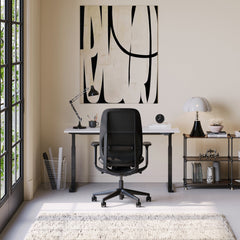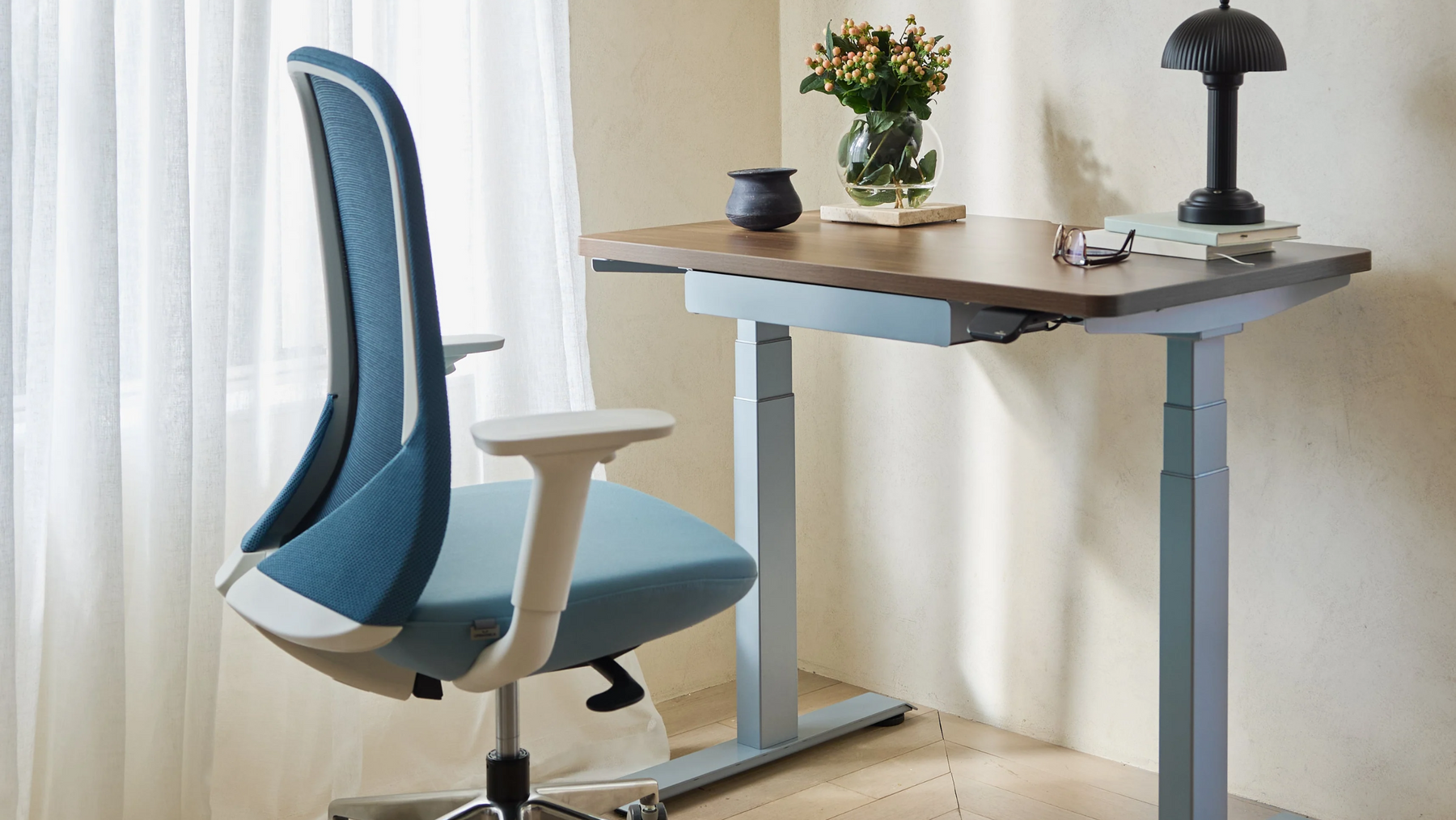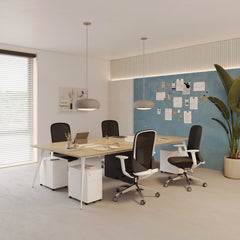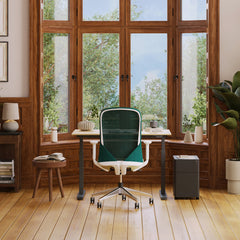Get 10% off your first order
Find the office furniture that’s designed to match your style, comfort, and needs perfectly. Subscribe
Beyond Desks and Chairs: How Cohesive Design Shapes Your Office Brand

Visit quiz page to see how we makes it easy to create an inspiring workplace

A well-designed office chair is the foundation of comfort and focus. Over time, every chair experiences wear that affects support, alignment, and usability. Recognizing when to replace or recycle a chair protects both health and sustainability goals, helping users make responsible, ergonomic choices for evolving workspaces.
Different materials fatigue in specific ways. Steel and aluminum frames resist deformation, while plastic bases can flex or crack with heavy use. Mesh maintains airflow but loses tension over time. Foam density determines how long cushioning can resist compression before forming pressure spots. Casters collect dust and hair that degrade rolling precision.
Metal bases distribute load evenly and provide reliable stability.
Plastic components may show whitening or hairline cracks under stress.
Welded joints must remain free of corrosion or visible separation.
Mesh fatigue appears as sagging at the lumbar zone.
Woven fabrics pill or fade in areas of repeated friction.
Synthetic leather can dry or crack with temperature and humidity shifts.
A chair used for multiple daily shifts will age faster than one used part-time. Hard floors increase caster wear compared to carpeted surfaces. Heat and sunlight accelerate aging in foam and vinyl, while humidity affects mechanical parts. Even subtle environmental changes, such as using floor mats, can extend lifespan.
High-performance ergonomic chairs use replaceable components and precision mechanisms to maintain comfort over time. Models such as the Novo ergonomic task chair demonstrate how robust frame design and breathable mesh can preserve alignment and resilience under consistent use.
Ergonomic standards recommend maintaining neutral posture with adjustable lumbar and arm supports. The NIOSH ergonomics guidance highlights that prolonged sitting without support increases musculoskeletal risk. When a chair can no longer enable safe alignment, replacement becomes a health priority.

Height adjustment slipping or dropping unexpectedly.
Base instability or uneven tilt.
Recline locks that fail to hold position.
Cracked or weakened arms and casters.
Clicking sounds during recline signaling worn pivots.
Uneven rolling caused by warped or debris-filled casters.
Seat pan tilt changes that suggest structural bending.
Discomfort that appears after short sessions, tight shoulders, or numbness in legs often means lost support. When adjustments no longer relieve pressure, internal materials have degraded. A new design such as the Muse chair with dynamic back support can restore posture balance and consistent comfort.
Some issues have simple fixes: replace casters, tighten bolts, or refresh padding. Cleaning and small adjustments can restore usability while reducing waste.
A chair with a fractured frame, leaking cylinder, or unreliable recline mechanism has reached structural end-of-life. Replacing prevents safety hazards and ensures proper ergonomics.
Designs built around durable frameworks often justify upkeep because their mechanical precision can be renewed. The Onyx high-performance ergonomic chair represents this concept, emphasizing longevity and adjustable comfort through careful maintenance.
| Chair Tier | Frame Type | Mechanism Quality | Comfort Retention | Recommended Action |
|---|---|---|---|---|
| Utility Task | Plastic base, limited adjustability | Basic tilt | Declines quickly | Replace when major parts fail |
| Mid Ergonomic | Reinforced frame, metal joints | Multi-adjustable | Holds shape longer | Maintain and replace small parts |
| Premium Ergonomic | Robust steel or aluminum core | Precision controls | Consistent long-term comfort | Maintain and refresh components |
Office chairs combine metals, plastics, and textiles that can often be separated for recycling. Steel and aluminum parts are widely accepted, while plastics must be identified by resin code. Removing non-recyclable padding helps reduce contamination.
Separate base, backrest, and cylinder with standard tools.
Group similar materials before recycling.
Remove mixed fasteners to simplify processing.
If a chair remains functional, donation is the most sustainable option. Schools, nonprofits, and startups often welcome ergonomic seating. A simple deep clean or replacement of arm caps can extend usability for years.
Some components can be repurposed for new furniture projects. Bases can become adjustable stools or stands. The Seashell sculpted chair design demonstrates recyclable construction principles that inspire creative reuse.
Neutral lumbar curves, adjustable armrests, synchronized recline, and breathable backs collectively support movement and circulation.
Task-oriented roles require structured lumbar and precise arm positioning, while creative environments benefit from flexible recline and open movement. Urbanica’s modern ergonomic seating collection offers a range of options tailored for different work styles.
| Feature | Mesh Seating | Padded Seating |
|---|---|---|
| Airflow | Excellent ventilation | Moderate |
| Maintenance | Simple cleaning | Periodic care |
| Pressure Relief | Firm, supportive | Soft, cushioned |
Choosing based on climate and posture habits ensures comfort consistency.
A correct seat height allows knees to form a right angle and feet to rest flat. Elbows should align with the desk surface, keeping wrists neutral and shoulders relaxed.
Proper desks complete ergonomic setups. Height, edge contour, and depth should encourage proximity without compression. The Urbanica desk range supports balance between aesthetics and body alignment.
Good lighting, organized layouts, and scheduled microbreaks maintain overall wellbeing. Integrating a supportive chair and ergonomic surface helps reduce long-term strain.

Clear debris from casters.
Tighten arm and base fasteners.
Inspect mesh tension and foam recovery.
Clean surfaces to remove abrasive particles.
Examine cylinder mounts for stress marks.
Test recline locks under full load.
Assess frame joints for subtle bends.
Routine attention extends both safety and comfort, reducing environmental impact through prevention rather than replacement.
1. Inspect structure for cracks or loosened joints.
2. Test mechanical adjustments for reliability.
3. Check ergonomic performance against comfort benchmarks.
4. Evaluate if repairs are accessible and cost-effective.
5. Choose appropriate recycling or donation pathways.
Irreparable structural damage: replace and recycle.
Minor wear with intact structure: repair and maintain.
Persistent discomfort with no visible failure: replace for ergonomic health.
Scheduled evaluation prevents sudden large-scale changes. Phasing updates across departments or home workstations promotes both continuity and budget efficiency.
Coordinating upgrades ensures cohesive style and ergonomic function. Using the Urbanica Build Your Bundle planner helps align seating, desks, and accessories while maintaining workspace balance.
Chairs used across rooms endure different surfaces and loads. Moving them often can loosen joints or scuff finishes. Regular inspection ensures ongoing reliability.
Moisture softens foam and weakens adhesives, while dryness can crack coated textiles. Maintaining stable humidity preserves feel and structure.
Soft casters for hard floors prevent scratches.
Hard casters for carpeted areas improve movement.
Locking casters add control for precise tasks.
Pivoting arms support forearms during typing, reducing shoulder elevation. If they fail to hold position, ergonomic alignment is compromised.
A supportive lumbar shape keeps the pelvis upright. When mesh or foam collapses and neutral posture cannot be maintained, replacement is warranted.
Chairs that harmonize with interior design encourage consistent use and mindful posture. Selecting designs with recyclable materials and replaceable components promotes both aesthetic appeal and environmental responsibility. The Seashell sculpted chair design represents a blend of visual refinement and sustainability principles that define the modern workspace.
The evolution of office seating is now part of a wider global movement toward sustainable and ergonomic design. Awareness of these regional and international initiatives helps organizations and individuals make informed, responsible purchasing decisions.
Many municipalities promote take-back and recycling programs for office furniture. Businesses can collaborate with certified recyclers to reclaim metal and plastic parts, reducing overall waste. Cities focused on circular economies often reward refurbishment and extended product life cycles.
In Europe and North America, adjustable seating and posture education are key parts of workplace wellness. In Asia-Pacific, compact ergonomic solutions accommodate smaller home offices. Despite regional variations, the focus on spinal health and adaptable comfort unites global standards.
Regional manufacturers increasingly use local materials to reduce emissions and respond quickly to design trends. Shorter supply chains strengthen local economies while supporting faster service and part replacement options.
Design preferences vary globally: Scandinavian regions value minimalist recyclable materials, North America prioritizes adaptability, and emerging economies emphasize durability and long service life. Each reflects how sustainability interacts with culture and climate.
Selecting chairs suited to regional climate improves comfort and longevity. Breathable mesh benefits humid environments, while padded seating retains warmth in cooler regions. Adapting materials and designs to geographic realities ensures ergonomic effectiveness and reduces premature wear.
Recognizing when to replace or recycle your office chair protects health, comfort, and the environment. An ergonomic upgrade chosen with awareness of materials, climate, and sustainability principles transforms the workspace into a balanced, responsible environment built for longevity and wellbeing.

Beyond Desks and Chairs: How Cohesive Design Shapes Your Office Brand

The Silent Energy Drain: Designing Tables and Chairs That Fight Work Fatigue

The Performance Equation: Unlocking Employee Potential with Ergonomic Design
Get 10% off your first order
Find the office furniture that’s designed to match your style, comfort, and needs perfectly. Subscribe
Leave a comment